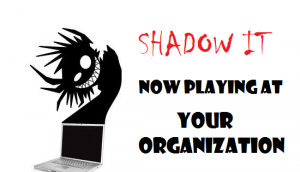Does the phrase “Shadow IT” make you nervous? When you think about your employees using apps and BYO devices on your network do you get the same feeling of dread that you did at 4 when the closet door was left open in your room at night? It is OK to admit it scares you.
In fact, if it didn’t scare you, you probably aren’t doing your job if you work in IT. Traditionally a basic tenant of our profession has been to safe guard our technology assets. We live in a world of heightened security awareness, firewalls, IPS/IDS, biometric authentication, access control lists and a myriad of other processes and procedures. All of these are in place to preserve the CIA triangle(Confidentiality, Integrity and Availability) of our data and resources to our business.
However, we also live in a digital world. Most people in our organizations have grown up with Atari to XBOX and a C64 to a Surface in their homes. If you don’t have a smart phone and a tablet you are being squeezed out of main stream society. Whether this is a good or bad thing is a topic for another post; but it is the reality of our everyday life. People expect to be informed, connected, entertained or just occupied by technology almost constantly.
Business has to realize the fact that happy employees have access to the tools that they perceive to make the life, both professional and personal, better. Whether this is having an app on their BYOD or even organization owned device like Evernote or Angry Birds. We as IT professionals need to understand that some of the control that was wielded for the last 40 years needs to be relaxed if not relinquished. We need to help our business attract and retain happy employees.
The Pandora’s Box of technology has been opened and there is no closing it. To think that you will continue to control how, what and when your employees use technology indefinitely is not practical. In my opinion you either embrace and integrate this fact of life or you become irrelevant.
From an IT point of view the first step is to understand why our employees engage in “shadow IT” activity. From my experience, primarily it is because the business is not giving them the tools that think they need. The other major reason is that they believe that IT won’t be accepting or helpful with implementing the technology they want to use.
Tackle the second issue first. Talk with the people of use your resources and services. Find out what they are doing with the technology they use. Don’t accuse or interrogate them, engage in a conversation. If you find out they are using Evernote your conversation might start something like “Hey, a saw you use Evernote too. I haven’t totally figured it out. What do you like about it?” Rather than “Why are you using Evernote? It isn’t an authorized app.” You can even start conversations about how they are using their technology for personal use. I have asked them, “Did you see that new episode of Dare Devil on Netflix yet? It is so cool that I can watch that on my tablet.”
The more you learn about what your users want and are doing the better off your business will be. Isn’t it better to know about what is going on rather than relying on a log file and analysis to find out? As an added bonus you build a rapport and trust with your employees. Over time this will translate into them engaging you as a partner in solving their technology challenges.
Just talking to people won’t fix the shadow IT problem. IT has to partner with their employees to figure out how to accommodate their needs. Sometimes these needs may not even have an obvious business case at first. Remember that one business case is that we want to retain a vibrant, engaged and innovative work force. Find ways to better accommodate the employees desires. The friendlier their work environment is the more likely they are to stay in it and perform their duties. This translates into more work hours and productivity.
A side benefit is that in this type of environment employees tend to be more creative and innovative. When they feel like their input is acknowledged and appreciated they will share more ideas that can be cultivated into new products, improved processes and procedures and more production.
IT’s challenge is to integrate these opportunities into our existing environments. The option to add more security to stop this transition isn’t sustainable. We need to provide better security to the assets that matter and design safer ways for people to use the technology they want.
We all know the role of IT is changing in today’s business. It is becoming the backbone of many organizations. There are some forward thinking CEOs, Presidents and board members that believe that no matter their line of business there is some truth to the statement “This is a technology company.” Our world is evolving into a digital one. From the “Internet of Things” to “the cloud” and the explosion of social/interactive media we are all becoming closer with family, friends, co-workers and our community through technology.
IT exists to enable business. Business depends on its employees to produce. Productive employees are happy employees. Happy employees don’t have strong distinctions between work and “life”. If we can further help to blur that line between how a person uses technology for work and leisure we will have happier, safer, more informed and engaged employees. Those employees will work with the business to bring the shadows into the light. Both in IT and other areas of the organization.
To learn more about engaging your employees start at http://www.usercentricit.com/ .
